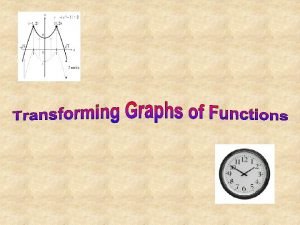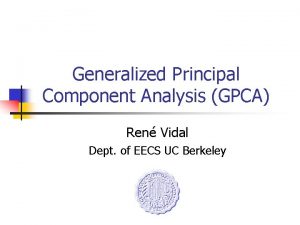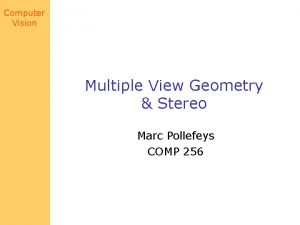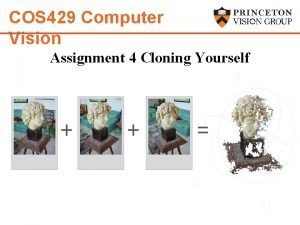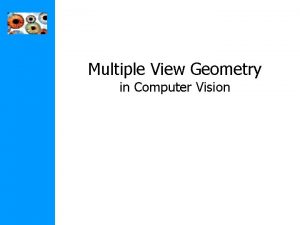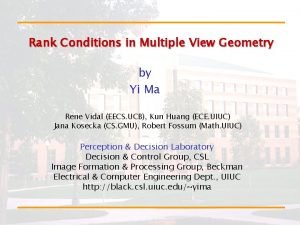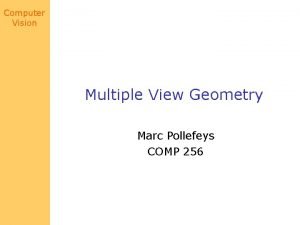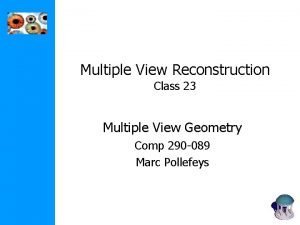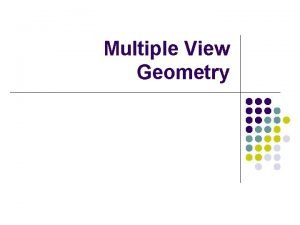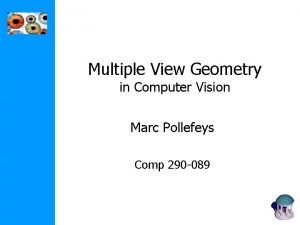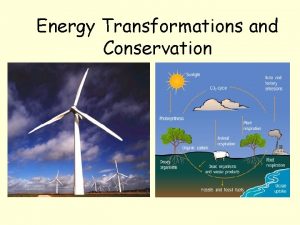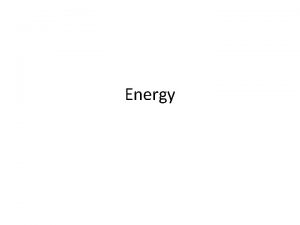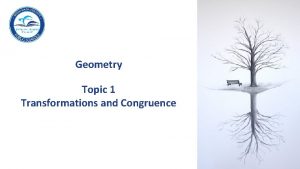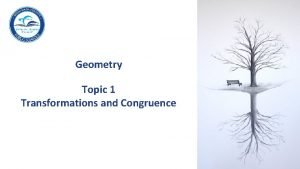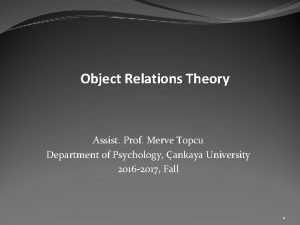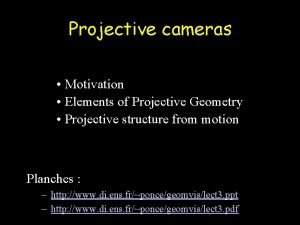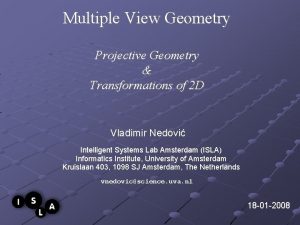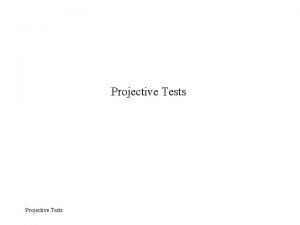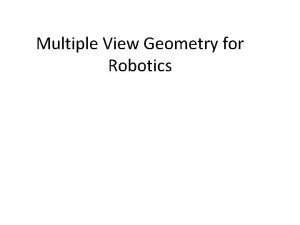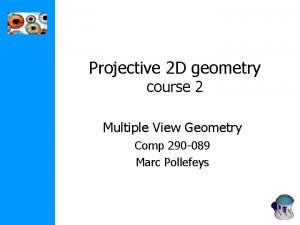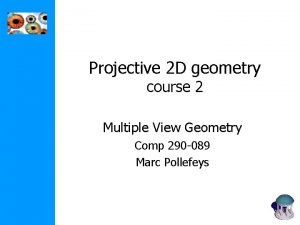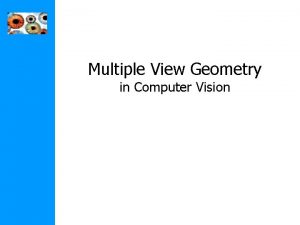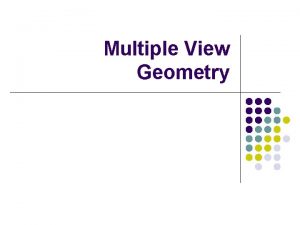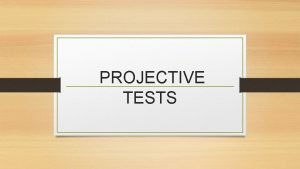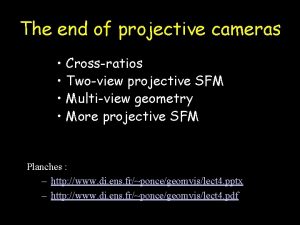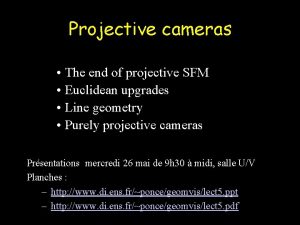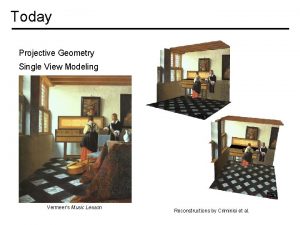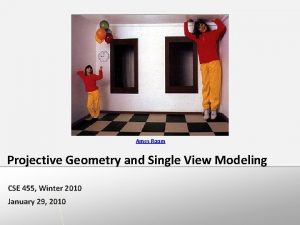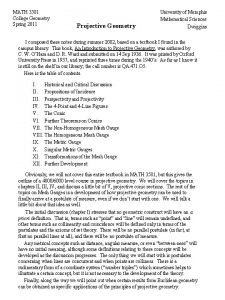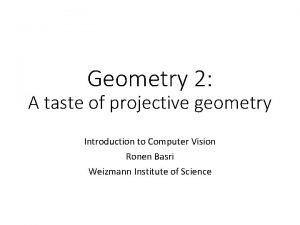Multiple View Geometry Projective Geometry Transformations of 2






















- Slides: 22

Multiple View Geometry Projective Geometry & Transformations of 2 D Vladimir Nedović Intelligent Systems Lab Amsterdam (ISLA) Informatics Institute, University of Amsterdam Kruislaan 403, 1098 SJ Amsterdam, The Netherlands vnedovic@science. uva. nl 18 -01 -2008

Outline Intro to projective geometry The 2 D projective plane Projective transformations Hierarchy of transformations Projective geometry of 1 D Recovery of affine & metric properties from images More properties of conics

Intro to Projective Geometry Projective transformation: any mapping of points in the plane that preserves straight lines Projective space: an extension of a Euclidean space in which two lines always meet in a point parallel lines meet at inf. => no parallelism in proj. space coordinates in Euclidean R 2 x = x/1 y = y/1 homogeneous coordinates in P 2 (x, y) = (x, y, 1) = (kx, ky, k) (x, y, 0) = (x/0, y/0, 0) = (∞, ∞, 0) k≠ 0 points at infinity

Intro to Projective Geometry (cont. ) Euclidean/affine transformation of Euclidean space: points at infinity remain at infinity ≠ Projective transformation of projective space: points at infinity map to arbitrary points (n+1)x(n+1) non-singular matrix x’ = H x a point in Pn, an (n+1) - vector In P 2, points at infinity form a line, in P 3 a plane, etc. e. g. an image of the real 3 D world e. g. the real 3 D world

The 2 D projective plane Line l in the plane: ax + by + c = 0 – equiv. to in slope-intercept notation – thus a line could be represented by a vector (a, b, c)T Lines and points represented by homogeneous vectors (a, b, c)T = k(a, b, c)T k≠ 0 (x, y)T = k(x, y)T A point x lies on line l iff ax + by + c = (x, y, 1)(a, b, c)T = x. Tl = 0

The 2 D projective plane (cont. ) The intersection of two lines l and l’ is the point: x = l x l’ The line through two points x and x’ can be analogously written as l = x x x’ duality principle Set of all points at infinity (= ideal points) in P 2 (e. g. (x 1, x 2, 0)T) lies on the line at infinity l∞ = (0, 0, 1)T P 2 = set of rays in R 3 through the origin (see Ch. 1) vectors k(x 1, x 2, x 3)T for diff. k form a single ray (a point in P 2) lines in P 2 are planes in R 3

The 2 D projective plane (cont. ) θ ideal l’ point l r 1 = k(x 1, x 2, x 3) r 2 = k(x 1’, x 2’, x 3’) x 1 x 2 -plane ≡ l∞ ≡ Ω l’ є Ω l, l’, r 1, r 2 є Λ r 2 x 1 θ r 1 x 2 x 3 = 1 Λ θ points in P 2 = rays through the origin point x 1 = ray r 1 lines in P 2 are planes Ω Fig 2. 1 (extended) e. g. line l is plane Λ

The 2 D projective plane (cont. ) Duality principle for 2 D projective geometry – for every theorem there is a dual one, obtained by interchanging the roles of points and lines A curve in Euclidean space corresponds to a conic in projective space – defined using points: x. TCx = 0 C is a homog. representation, only the ratios of elements matter – defined using (tangent) lines: l. TC-1 l = 0 via the equation of a conic tangent at x: l = Cx C-1 only if C non-singular, otherwise C* if C not of full rank, the conic is degenerate

Projective transformations Remember slide 1? Projectivity = homography = invertible mapping in P 2 that preserves lines – algebraically, mapping described by the matrix H again only element ratios matter => H = homogeneous matrix – leaves all projective properties of the figure invariant Fig. 2. 3 (extended) x 1’ central projection preserves lines => a projectivity

Projective transformations (cont. ) Effect of central projection (e. g. distorted shape) is described by H => inverse transformation leads back to the original (via H-1) H can be calculated from 4 point correspondences (i. e. 8 linear equations) between the original (e. g. the 3 D world) and the projection (e. g. the image) Points transform according to H, but lines transform according to H-1: l’T= l. TH-1 For a conic, the transformation is C’ = H-TCH-1

A hierarchy of transformations Projective transformations form a group, PL(3) – characterized by invertible 3 x 3 matrices In terms of increased specialization: 1. Isometry 2. Similarity 3. Affine 4. Projective Can be described algebraically (i. e. via the transform matrix) or in terms of invariants similarity affine projective

A transformation hierarchy: Isometries Transformations in R 2 preserving Euclidean dist. – ε is affecting orientation e. g. in a composition of reflection & Eucl. trans. if ε = 1, isometry = Euclidean transformation – Eucl. trans. model the motion of a rigid object needs 2 point correspondences rotation matrix Z Invariants: length, angle, area Preserves orientation if det(Z)=1 translation 2 -vector

A transformation hierarchy: Similarity I. e. isometry + isotropic scaling – – also called equi-form, since it preserves shape in its planar form, needs 2 point correspondences If isometry does not include reflection, matrix is scaling factor Invariants: angles, parallel lines, ratio of lengths (not length itself!), ratio of areas Metric structure: something defined up to a similarity

A transformation hierarchy: Affine Non-singular linear transformation + translation – can be computed from 3 point correspondences – invariants: parallel lines, ratios of lengths of their segments, ratio of areas 2 x 2 non-singular matrix defining linear transformation essence of affinity, separate scaling in orthog. directions Can be thought of as the composition of rotations and non-isotropic scalings – the affine matrix A is then A = R(θ)R(-φ)DR(φ), rotation by θ rotation back by -φ scaling by λ 1 and λ 2 rotation by φ

A transformation hierarchy: Projective Most general linear trans. of homog. coords. – – i. e. the one that only preserves straight lines affine was as general, but in inhomogeneous coords. requires 4 point correspondences the block form of the matrix is v = (v 1, v 2)T (not null as with affine => non-linear effects) Invariants: cross-ratio of 4 collinear points (i. e. the ratio of ratios of line segments)

Comparison of transformations Affine are between similarities and projectivities: – angles not preserved => shapes skewed – but effect homogeneous over the entire plane – orientation of transformed line depends only on orientation, not on planar position of source – ideal points remain at infinity Projectivities: – – – area scaling varies with position orientation of trans. line depends on both orientation & position ideal points map to finite points (thus vanishing points modeled) Projectivity can be decomposed into a chain of more specific transformations: A = s. RK + tv. T, det(K) = 1

Projective geometry of 1 D Very similar to 2 D – proj. trans. of the plane implies a 1 D proj. trans. of every line in the plane Proj. trans. for a line is a 2 x 2 homog. matrix – thus 3 point correspondences required Cross ratio is the basic projective invariant in 1 D Dual to collinear points are concurrent lines, also having a P 1 geometry signed distance from one to another (if each is a finite point, and homog. coord. is 1)

Recovery of affine & metric properties from images Recover metric properties (i. e. up to a similarity) 1. by using 4 points to completely remove projective distortion 2. by identifying line at infinity l∞ and two circular points (i. e. their images) Affine is the most general trans. for which l∞ remains a fixed line – but point-wise correspondence achieved only if the point is an eigenvector of A Once l∞ is identified in the image, affine measurements can be made in the original – e. g. parallel lines can be identified, length ratios computed, etc.

Recovery of affine & metric properties from images (cont. ) But identified l∞ can also be transformed to l∞ = (0, 0, 1)T with a suitable proj. matrix – – such a matrix could be this matrix can then be applied to all points, and affine measurements made in the recovered image Figure 2. 12

Recovery of affine & metric properties from images (cont. ) Beside the line at infinity, the two circular points are fixed under similarity – – i. e. a pair of complex conjugates every circle intersects l∞ at these Metric rectification is possible if circular points are transformed into their canonical positions – applying the transformation to the entire image results in a similarity The degenerate line conic is dual to circ. points – – once it is identified, Euclidean angles and length rations can be measured direct metric rectification also possible

Properties of conics Some point x and some conic C define a line l = Cx (i. e. a polar of x w. r. t. C) – the line intersects the conic at 2 points -> the tangents at these points intersect at x The conic induces a map between points & lines of P 2 – – a projective invariant (involves only intersection & tangency) called correlation, represented by a 3 x 3 matrix A: l = Ax For two points x and y, if x is on the polar of y, then y is on the polar of x Any conic is projectively equiv. to one with a diagonal matrix – classification based on diag. elements – hyperbola, ellipse & parabola from Eucl. geom. projectively equiv. to a circle (still valid in affine geom. )

The End !
 Multiple transformations geometry
Multiple transformations geometry Absolute conic
Absolute conic Multiple view geometry
Multiple view geometry Multiple view geometry in computer vision solution manual
Multiple view geometry in computer vision solution manual Multiple view geometry
Multiple view geometry Multiple view geometry
Multiple view geometry Multiple view geometry
Multiple view geometry Tensor notation
Tensor notation Multiple view geometry
Multiple view geometry Epipolar line
Epipolar line Multiple view geometry in computer vision
Multiple view geometry in computer vision Single energy transformation
Single energy transformation Multiple transformations occur when
Multiple transformations occur when Geometry topic 1 review
Geometry topic 1 review Transformations and congruence
Transformations and congruence Multiple baseline vs multiple probe design
Multiple baseline vs multiple probe design Multiple instruction multiple data
Multiple instruction multiple data Intuitive projective faith
Intuitive projective faith Undoing defense mechanism examples
Undoing defense mechanism examples Ambiguous stimuli test
Ambiguous stimuli test Publicité mécaniste
Publicité mécaniste Projective identification.
Projective identification. Bandura's reciprocal determinism
Bandura's reciprocal determinism
